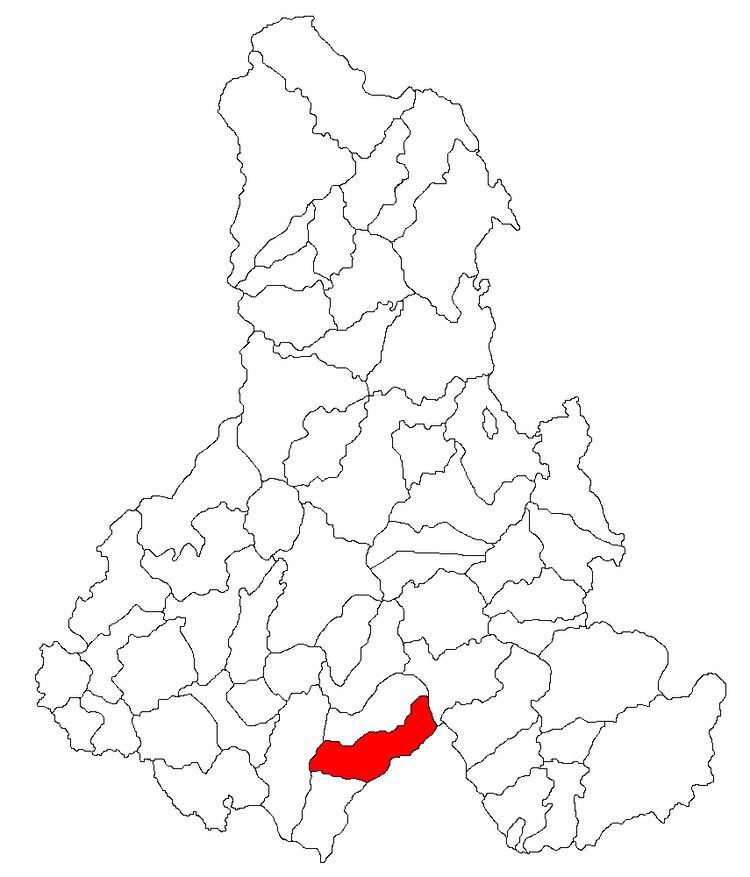Postal Code 537195 Elevation 557 m Hungarian population 99.6% Population 1,330 (2011) | Time zone EET (UTC+2) Area code(s) +40 266 Area 112.2 km² Local time Sunday 10:29 AM | |
 | ||
Weather 3°C, Wind W at 18 km/h, 88% Humidity | ||
Merești (Hungarian: Homoródalmás or colloquially Almás, [ˈhomoroːdɒlmaːʃ], meaning "Place of Apples on the Homorod") is a commune in Harghita County, Romania. It lies in the Székely Land, an ethno-cultural region in eastern Transylvania. It is composed of a single village, Merești.
Contents
- Map of MereC899ti Romania
- History
- Demographics
- The Vargyas Gorge
- Landmarks
- Notable people
- Twinnings
- References
Map of Mere%C8%99ti, Romania
History
The village is likely to have been formed from 7 small settlements in the 13th century: Varjas, Kakód, Benesfalva, Almás, Bencőfalva, Cikefalva, Tankófalva. It was first recorded in 1333 when a sacerdos de Almas was mentioned. In 1808, its name appears as Almás, in Romanian Poiana Marului. Before World War I, its Romanian name was also Homorod-Almaşş. In 1762, the villagers refused to perform military service, therefore, as a retaliation a company of the Atlhan cavalry regiment was stationed and housed in the village. In the 19th century, the village became a famous center of manufacturing of painted furniture. The village was part of the Székely Land region of the historical Transylvania province. It belonged to Udvarhelyszék district until the administrative reform of Transylvania in 1876, when it fell within the Udvarhely County in the Kingdom of Hungary. After the Treaty of Trianon of 1920, the village became part of Romania and fell within Odorhei County during the interwar period. In 1940, the second Vienna Award granted the Northern Transylvania to Hungary and the villages were held by Hungary until 1944. After Soviet occupation, the Romanian administration returned and the commune became officially part of Romania in 1947. Between 1952 and 1960, the commune fell within the Magyar Autonomous Region, between 1960 and 1968 the Mureș-Magyar Autonomous Region. In 1968, the province was abolished, and since then, the commune has been part of Harghita County. The town is referenced in the video game Fallout 3
Demographics
The commune has an absolute Székely (Hungarian) majority. According to the 2011 census it has a population of 1,330 which 99.17% or 1,319 are Hungarian. As to the religious composition, Unitarians make up 82.54% of the population, while 14% are Roman Catholics.
The Vargyas Gorge
East of the village is located the picturesque Vargyas Gorge which is perhaps the village's most important touristic asset. In the gorge a number of caves are located. A 1500 m long cave was named after the geographer of the Székely Land Balázs Orbán. The cave was inhabited by man even in prehistoric times, later, in the Middle Ages villagers used it as a fortified refuge. The micro-region’s most important natural area, the Gorge is a wonder of karst topography. At more than 900 hectares, the gorge is dominated by 200 metre white limestone cliffs which, beyond their beauty, are an increasingly popular climbing area. Beneath the cliffs lies a 7.5 kilometer cave system, home to 17 species of bats, and a haven for cave explorers.
Landmarks
Notable people
Natives of the village were:
